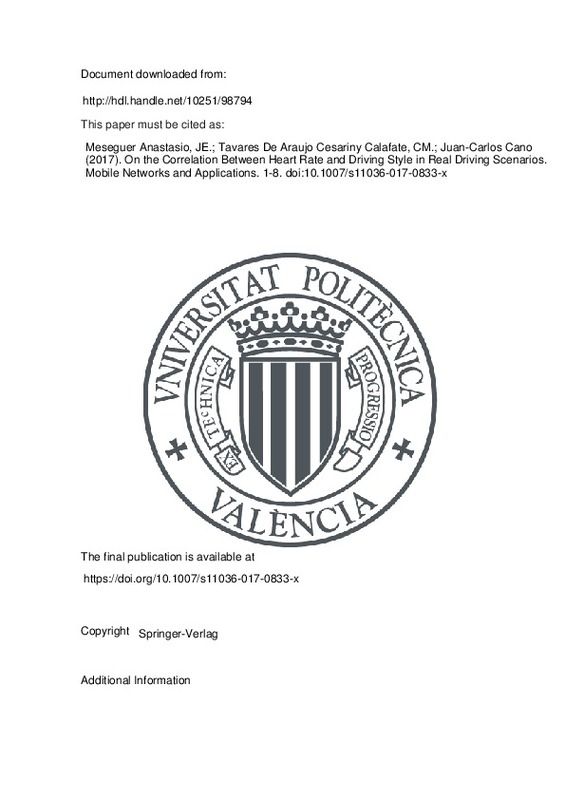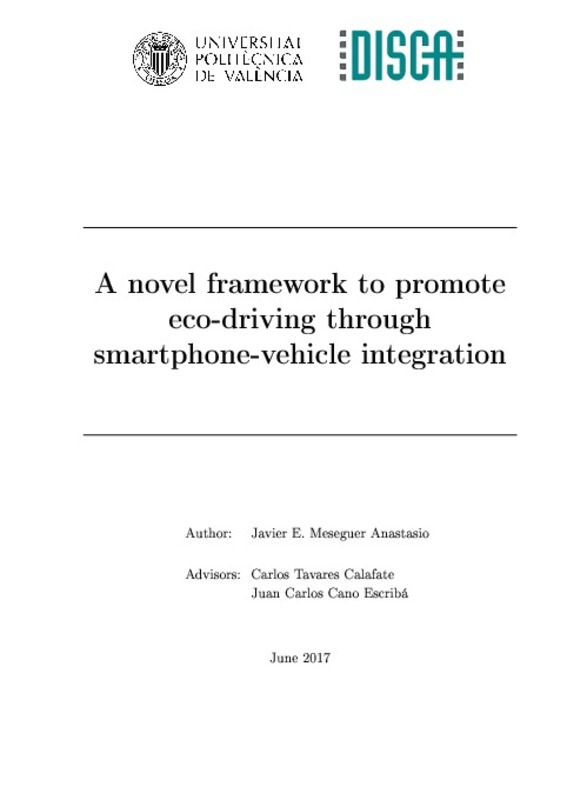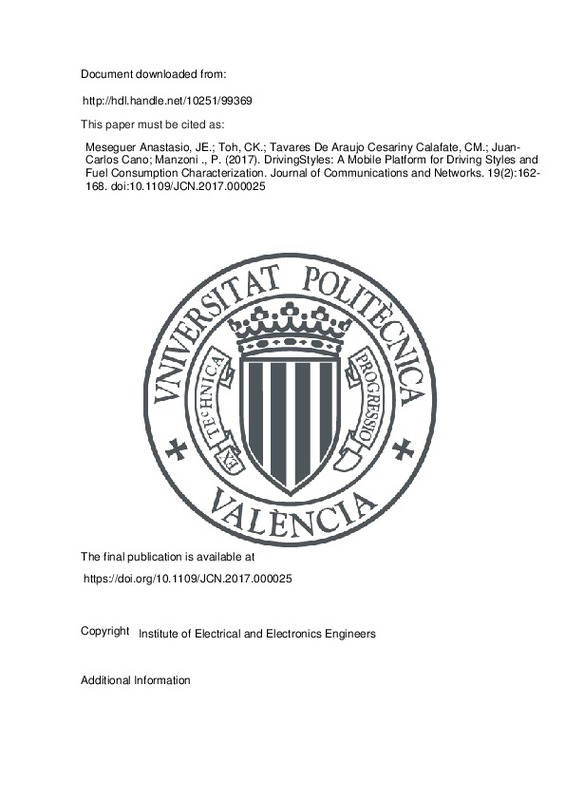JavaScript is disabled for your browser. Some features of this site may not work without it.
Buscar en RiuNet
Listar
Mi cuenta
Estadísticas
Ayuda RiuNet
Admin. UPV
On the Correlation Between Heart Rate and Driving Style in Real Driving Scenarios
Mostrar el registro sencillo del ítem
Ficheros en el ítem
| dc.contributor.author | Meseguer Anastasio, Javier Enrique
|
es_ES |
| dc.contributor.author | Tavares de Araujo Cesariny Calafate, Carlos Miguel
|
es_ES |
| dc.contributor.author | Cano, Juan-Carlos
|
es_ES |
| dc.date.accessioned | 2018-03-05T05:26:49Z | |
| dc.date.available | 2018-03-05T05:26:49Z | |
| dc.date.issued | 2017 | es_ES |
| dc.identifier.issn | 1383-469X | es_ES |
| dc.identifier.uri | http://hdl.handle.net/10251/98794 | |
| dc.description.abstract | [EN] Driving safety is of utmost importance in our society. The number of fatalities due to car accidents is still very high, and reducing this trend requires as much attention as possible. There are situations where the emotional conditions of drivers vary due to reasons beyond their control, or because they decide to change their driving style. Hence, we consider that such frequent situations deserve more scrutiny. In this work we addressed such issues by designing an Android application able to monitor in real-time both physiological data from the driver and diagnostic data from the vehicle (this data is obtained using an OBD-II connector) to study their correlation. Among the various non-invasive biomedical sensors available nowadays, we have adopted heart rate sensors, either packaged in belts or in smart watches. This allows studying the relationship between driving aggressiveness and heart rate. For our analysis we focused on fourteen different routes accounting a total driving time of 6 hours and 2 minutes, which we have split into three separate categories: urban, suburban, and highway routes. We analyzed the correlation between the heart rate and the driving style for each of the three groups. Our experiments show that the differences in terms of heart rate between quiet and aggressive behavior range between 2.5 % and 3 % beats per minute higher for the latter behaviour compared to the former. | es_ES |
| dc.description.sponsorship | This work was partially supported by the Ministerio de Economia y Competitividad, Programa Estatal de Investigacion, Desarrollo e Innovacion Orientada a los Retos de la Sociedad, Proyectos I+D+I 2014, Spain, under Grant TEC2014-52690-R. | en_EN |
| dc.language | Inglés | es_ES |
| dc.publisher | Springer-Verlag | es_ES |
| dc.relation.ispartof | Mobile Networks and Applications | es_ES |
| dc.rights | Reserva de todos los derechos | es_ES |
| dc.subject | Driving styles | es_ES |
| dc.subject | Driving behavior | es_ES |
| dc.subject | Heart rate | es_ES |
| dc.subject | Eco-driving | es_ES |
| dc.subject | Consumption | es_ES |
| dc.subject | Road safety | es_ES |
| dc.subject.classification | ARQUITECTURA Y TECNOLOGIA DE COMPUTADORES | es_ES |
| dc.title | On the Correlation Between Heart Rate and Driving Style in Real Driving Scenarios | es_ES |
| dc.type | Artículo | es_ES |
| dc.identifier.doi | 10.1007/s11036-017-0833-x | es_ES |
| dc.relation.projectID | info:eu-repo/grantAgreement/MINECO//TEC2014-52690-R/ES/INTEGRACION DEL SMARTPHONE Y EL VEHICULO PARA CONECTAR CONDUCTORES, SENSORES Y ENTORNO A TRAVES DE UNA ARQUITECTURA DE SERVICIOS FUNCIONALES/ | es_ES |
| dc.rights.accessRights | Abierto | es_ES |
| dc.contributor.affiliation | Universitat Politècnica de València. Departamento de Informática de Sistemas y Computadores - Departament d'Informàtica de Sistemes i Computadors | es_ES |
| dc.description.bibliographicCitation | Meseguer Anastasio, JE.; Tavares De Araujo Cesariny Calafate, CM.; Cano, J. (2017). On the Correlation Between Heart Rate and Driving Style in Real Driving Scenarios. Mobile Networks and Applications. 1-8. doi:10.1007/s11036-017-0833-x | es_ES |
| dc.description.accrualMethod | S | es_ES |
| dc.relation.publisherversion | https://doi.org/10.1007/s11036-017-0833-x | es_ES |
| dc.description.upvformatpinicio | 1 | es_ES |
| dc.description.upvformatpfin | 8 | es_ES |
| dc.type.version | info:eu-repo/semantics/publishedVersion | es_ES |
| dc.relation.pasarela | S\327411 | es_ES |
| dc.contributor.funder | Ministerio de Economía, Industria y Competitividad | es_ES |
| dc.description.references | Gibson PM, Wiesenthal DL (1996) The Driving Vengeance Questionnaire (DVQ): the development of a scale to measure deviant drivers, LaMarsh Research Programme Report Series, No. 54 | es_ES |
| dc.description.references | Cohen S (1980) After effects of stress on human performance and social behavior: a review of research and theory. Psychol Bull 88:82–108 | es_ES |
| dc.description.references | Gravina R, Fortino G (2016) Automatic Methods for the Detection of Accelerative Cardiac Defense Response. IEEE Trans Affect Comput 7(3): | es_ES |
| dc.description.references | Andreoli A et al SPINE-HRV: A BSN-based toolkit for heart rate variability analysis in the time-domain, Wearable and Autonomous Systems, pp 369–389 | es_ES |
| dc.description.references | Karel A, Cornelie JG, Tineke H (2001) Driving with a congestion assistant; mental workload and acceptance. Psychophysiol Ergon 40(6):1019–1025 | es_ES |
| dc.description.references | Shuii S, Kazushi T, Masanori K (2001) Heart rate variability during long truck driving work. J Human Ergol 30(1-2):235–240 | es_ES |
| dc.description.references | Keyword Protocol 2000 (1999) International Organization for Standardization | es_ES |
| dc.description.references | ISO 9141-2:1994/Amd 1:1996,1196 (1996) International Organization for Standardization | es_ES |
| dc.description.references | Khan MA, Raza A (2013) Development of an On-board Diagnostic (OBD) Kit for Troubleshooting of Compliant Vehicle, Emerging Technologies (ICET), 2013 IEEE 9th International Conference | es_ES |
| dc.description.references | Haykin S (1994) Neural Networks: A Comprehen-sive Foundation, Macmillan, p 2 | es_ES |
| dc.description.references | Hecht-Nielsen R (1989) Theory of the backpropagation neural network - Neural Networks, IJCNN., International Joint Conference | es_ES |
| dc.description.references | Meseguer J.E, Calafate C.T, Cano JC, Manzoni P (2015) Assessing the Impact of Driving Behavior on Instantaneous Fuel Consumption, IEEE 12th Consumer Communications and Networking Conference | es_ES |
| dc.description.references | Kuhler M, Kartens D (1978) Improved driving cycle for testing automotive exhaust emissions, SAE Technical Paper Series 780650 | es_ES |
| dc.description.references | Johansson H et al (2003) Impact of EcoDriving on emissions. International Scientific Symposium on Transport and Air Pollution, Avignon, France | es_ES |
| dc.description.references | Rakha H (2011) Simple Comprehensive Fuel Consumption and CO2 Emission Model based on Instantaneous Vehicle Power. Transportation Research Board Annual Meeting, Washington, D.C. | es_ES |
| dc.description.references | Meseguer JE, Calafate CT, Cano JC, Manzoni P (2013) DrivingStyles: a smartphone application to assess driver behavior, 18th IEEE symposium on Computers and Communications | es_ES |
| dc.description.references | Riener A (2012) Subliminal Persuasion and Its Potential for Driver Behavior Adaptation, IEEE Transactions On Intelligent Transportation, pp 1–10 | es_ES |
| dc.description.references | ELM327DS (2010) OBD to RS232 Interpreter, Elm Electronics Circuits | es_ES |
| dc.description.references | Lajunen T, Parker D, Summala H (1999) Does traffic congestion increase driver aggression?, Transportation Research Part F2 225-236 | es_ES |







![[Cerrado]](/themes/UPV/images/candado.png)



